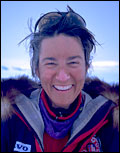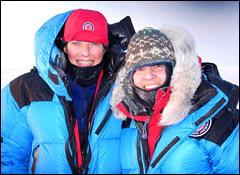
Ann Bancroft.
What work do you do?
I typically call myself an educator, explorer, and lecturer. I have been lucky in life to blend my passions for teaching and the outdoor world together.
In 1986, I joined the Steger International Polar Expedition, a team of seven men and 49 male dogs. After reaching the North Pole as the first known woman to cross the ice, I was thrust into a new role and a new understanding of what I could do merging education and expeditions.
In 1992 and 1993, I mounted an all-female expedition across Greenland from east to west, and then from the edge of Antarctica to the South Pole. In 2000 and 2001, I invited Norwegian explorer Liv Arnesen to join me in trying to cross Antarctica from Queen Maud Land to the Ross Ice Shelf by ski and sail. Liv and I have been working together ever since; we share both a love of outdoor travel and a desire to use these expeditions as a way to motivate and inspire young people.

How does it relate to the environment?
I use expeditions as a platform from which to teach and engage young people. I open their eyes to their dreams and potential, to the adventure in their own backyards, and to global-warming issues. I direct them to be an active part of the solution.
Typically, there is excitement around the adventures Liv and I take. We utilize this excitement to open discussions of the above topics while people are following the expeditions. We expand on these discussions by providing educators with curricula that are designed to complement what is already taking place in the classrooms. The curricula are free and can be used in lots of ways. Teachers are extremely creative, and each time we have found that they expand upon what is offered in terrific ways. The expeditions are great metaphors for much that is going on in the classroom.
What are you working on at the moment?
The current project is global warming. Although a huge crisis, it is one that will turn in a positive direction with the involvement of many. If we all take small steps to change or alter our actions we can have a huge effect. The collective power of many is unstoppable.
When we started planning our most recent expedition two years ago, our main goal was to broaden the discussion — there was little discussion going on at all in this country. By talking about what is happening in the Arctic as we travel, we hope to empower people, particularly young people, to understand and engage in the solutions. Like an expedition, many small steps start to accumulate and make a difference. We as ordinary citizens can make a difference in so many ways to stem global warming.
How do you get to work?
I work part time out of my home, so I can simply walk downstairs to my home office. Other times I drive or ride a bike to a shared space in Twin Cities, Minn. My other office is on the ice caps of the world, and I pull a sled with all of my belongings.
What long and winding road led you to your current position?
I was a traditional teacher with a love of the outdoors. Twenty-two years ago I discovered I could merge my passions into one. I took a leave of absence to join the team to the North Pole. Upon my return, I discovered my entire school took my adventure as an opportunity to teach and learn. Seeing every subject come to life through my expedition showed me a way to be a teacher outside the four walls of the classroom and bring it to kids all over the world.
The North Pole expedition 21 years ago was a dream come true for me. We traveled as far north as possible by dog team, and we had no GPSs or satellite phones as we do now. Communication to the outside world was sparse. I had a real sense of what it might have felt like to be one of the early explorers who ignited these dreams for me as a young girl.
Where were you born? Where do you live now?
I was born in St. Paul, Minn. Now I live in Scandia, Minn., on the St. Croix River.
What has been the worst moment in your professional life to date?
Recently having to turn back after only one week on the Arctic Ocean due to frostbite on my teammate’s toes.

Liv Arnesen (left) and Ann Bancroft.
Photo: Ann Bancroft
Problems on expeditions are typically a series of small things that accumulate to create an issue. In our case, we were on Ward Hunt Island getting ready to go when a plane with skis came in to drop off a group, just as it had with us the day before. After losing control on the landing because of hitting rocks and ice, it swerved in our direction. It hit one of our sleds and one of Liv Arnesen’s snowshoes. We repaired the shoe and got under way.
Our sleds were extremely heavy with supplies for 60 days, and the condition of the ice made travel brutal — it was more like sand than ice. This meant that Liv and I were bent way over our snowshoes to try and move forward. And lastly, it was indeed cold — although not colder than we expected, as it is generally very cold in the first part of March before the sun gets a chance to return to much strength. But the cold, the pressure our creative fix of the binding created, and the weight of sleds all led to an unknown problem on Liv’s foot. On the sixth day we discovered three black toes with no prior warning, which is very unusual. But as we have come to learn over and over again on long journeys in harsh conditions, little can go wrong because your margin of error is so slim.
What’s been the best?
Crossing Antarctica with Liv in 2001. We crossed the continent on skis, using the wind to sail when possible. It took us 95 days. We planned our expedition with the wind and sails as a main mode of transportation. When we arrived that season, we found ourselves in the calmest summer in the history of Antarctic wind charting. This made for a huge challenge, crossing such a huge distance in the summer season. We were the first women to do this.
Who is your environmental hero?
Aldo Leopold.
How do you spend your free time (if you have any)? Read any good books lately?
I’m doing a lot of reading on the Arctic National Wildlife Refuge: Arctic Refuge: A Circle of Testimony, a collection of writings compiled by Hank Lentfer and Carolyn Servid and Caribou Rising, by Rick Bass. And a book on the Arctic itself, Silent Snow.
What’s your favorite meal?
Veggies from the garden in late summer.
Which stereotype about environmentalists most fits you?
I really do hug trees!
What’s your favorite place or ecosystem?
Hard to say a favorite; however, I do spend a lot of time in polar regions. I’m very drawn to Africa as well.
If you could institute by fiat one environmental reform, what would it be?
I’d legislate sweeping reforms on emissions of greenhouse gases from fossil fuels.
Who was your favorite musical artist when you were 18? How about now?
When I was 18, Cat Stevens. Now, too eclectic to say.
What’s your favorite TV show? Movie?
TV: Sunday Morning. Movie: Sweet Land.
If you could have every InterActivist reader do one thing, what would it be?
Tell a friend to engage with you on small things to cut humans’ contribution to global warming. Little things I am doing: unplugging my electronic stuff, as there is a slow drain when they’re simply plugged in, and using all my tote bags at the grocery store rather than what they offer us. Then you don’t even have to think if plastic or paper takes more energy to create and recycle. I’ve pretty much switched all cleaners in our household to natural or eco-friendly. Use rags instead of paper towels, don’t idle the car in bank lines, watch water consumption, buy locally whenever possible — our food travels great distances. Keep talking to people about what you are doing to cut back. It starts to become fun for the whole family.


